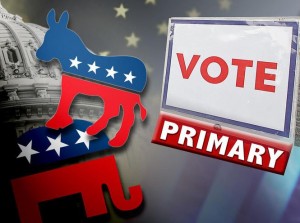Why have primaries?
Article One of the Constitution has the following clause relating to general elections –
Clause 1: Time, place, and manner of holding
The Times, Places and Manner of holding Elections for Senators and Representatives, shall be prescribed in each State by the Legislature thereof; but the Congress may at any time by Law make or alter such Regulations, except as to the Places of chusing (sic) Senators.
States are not obligated to have primaries, as only general elections are required by our Constitution. But they do to control the electoral process, to select preferred candidates.
Those primaries are also scattered throughout the election year. Only a fraction of the voting public actually vote in the primary elections, and far fewer in a runoff if needed. Most states don’t have runoffs, and the winner with the most votes takes all.
A runoff occurs, in those states that have them, where a single candidate doesn’t get 50.1% of the primary vote. That’s called a plurality. The top two candidates have a second election to select the one that moves on to the general election in November. I wrote about the process here.
If a voter is actually going to vote, they’ll vote in the general election and probably not the primary. By that time, it’s far too late for the majority of voters to pick his or her favorite candidates. Why?
Let’s say that your electoral district has 450,000 registered voters. Of these voters, a fraction, 100,000 actually vote in the primary. And for this example let’s say that there are six candidates for a congressional job.
The only candidate in the general election, in most states, is the one selected by the majority of the 100,000 voters and not who gets at least a plurality of 50.1% of the votes. For example, four of the candidates get 10,000 votes each leaving 60,000 votes for the top two. The winner gets 30,001 votes and the other person 29,999. As these states don’t have a runoff, the 30,001 votes wins. That’s about 6% of the eligible voters who pick is the person that the public vote on in the general election. So 6% controls the election outcome.
It’s far worse for presidential elections.
As a small number of states precede the Super Tuesday (ST) elections, many candidates will have dropped out if not by ST, then immediately afterwards. Even worse, the majority of states such as the biggest, California, don’t vote for months after the primary candidate selections are essentially over. By the time they get to vote, it’s all over and they are given the choice of the two candidates left standing who can still afford to be running.
It’s as though a single state decides that only a few counties within that state should vote first. Only the top two candidates can be voted for from each party by the other counties afterwards. The public would be very upset, but miss the point about our sequential presidential system. That’s because of state voter isolation and lack of interest.
At the state level, the 15% who vote for this candidate are the ones that let the majority pick from. It’s a done deal; 6% of the people who vote at the right time elect the congressman or woman. And you thought elections were fair and represented the will of the people.
Twenty two percent of the eligible voters choose that candidate that will be on the General Election ballot. If there isn’t an opposing candidate, that candidate will win. As many district boundaries have been (fraudulently) changed to assure a win by one party or the other, that candidate will win.
On the other hand, where there is a state mandated runoff, the top two are voted for by an even smaller group of perhaps 10,000 voters. So 10,000 people decide who 450,000 voters get to choose from in the General Election. That about 2% of the voting public controls the other 98% of the voters’ choices!
Most voters will only vote once and that’s in the November general election; they want to avoid voter fatigue so only the committed vote in the primaries and the runoffs.
So here’s my suggestion… forget the primary elections, that are expensive for the states and counties to organize and block the ability for the majority of the voters to vote for candidates of their choice. The aren’t even mentioned in our Constitution, they were created by the political parties to sort through the candidates… at taxpayer expense.
Just have the general election in November with all of the qualified candidates for the majority of voters to choose from. Whoever gets the most votes, wins. Period. Forget plurality; it’s a ruse to persuade the public to believe that the winning candidate actually represents the voters will.
That will put to rest the “landslide” bravado as the winning candidate may only receive 35% of the votes. Politicians don’t usually get mandates; they just hang on and pretend they do.
If a state insists on a primary, then perhaps any candidate that gets at least 5% of the votes moves forward to the general election and not just one. Usually the more money a candidate raises (or uses from a previous campaign) the more votes they get. The underfunded candidate who wins will make the national news, as it’s a rarity for that candidate will win. I can fix that if I’m well funded and my campaign voice is heard. It’s an easy fix.
A simple computer program or algorithm could fix the gerrymandering problem so that close to 50% in any district are Democrats and 50% are Republicans and the voters could decide who is best. It isn’t that way because the major parties don’t want the system to be fair.
Choice is everything, and the public doesn’t get it.





